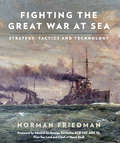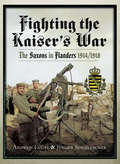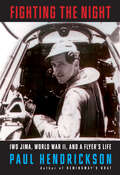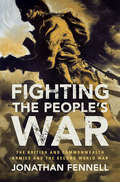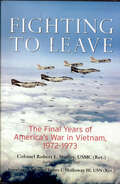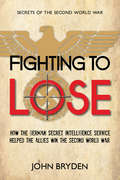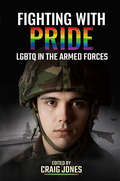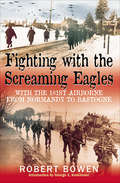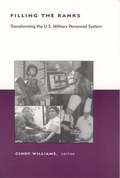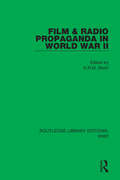- Table View
- List View
Fighting the Great War at Sea: Strategy, Tactic and Technology
by Norman FriedmanWinner of the John Lyman Book Award for Naval and Maritime Science and Technology. &“A compelling and convincing historical analysis of World War I.&” —Navy News While the overriding image of the First World War is of the bloody stalemate on the western front, the overall shape of the war arose out of its maritime character. It was essentially a struggle about access to worldwide resources, most clearly seen in Germany&’s desperate attempts to counter the American industrial threat, which ultimately drew the United States into the war. This radical new book concentrates on the way in which each side tried to use or deny the sea to the other, and in so doing, describes rapid wartime changes not only in ship and weapons technology but also in the way naval warfare was envisaged and fought. Melding strategic, technical, and tactical aspects, Friedman approaches the First World War from a fresh perspective and demonstrates how its perceived lessons dominated the way navies prepared for the Second World War. &“Friedman is a master of the evolution of naval strategy, tactics and technology . . . a rewarding read that will leave many wanting to return again and again just to see what they might have missed the first time.&” —Australian Naval Institute &“Dr. Friedman&’s research credentials are impeccable, and the huge amount of factual detail he has unearthed will be sure to delight many . . . there is nothing comparable in either depth or scope out there, and for this reason, if no other, this book is likely to become a standard work on the naval aspects of the Great War.&” —Naval War College Review
Fighting the Great War: A Global History
by Michael S. NeibergThe book with latest references and insight, dwells into history to illuminate readers on the First World War, how it all began and how the conflict became global, slaughtering thousands of lives.
Fighting the Great War: A Global History
by Michael S. NeibergDespair at Gallipoli. Victory at Vimy Ridge. A European generation lost, an American spirit found. The First World War, the deadly herald of a new era, continues to captivate readers. In this lively book, Michael Neiberg offers a concise history based on the latest research and insights into the soldiers, commanders, battles, and legacies of the Great War. Tracing the war from Verdun to Salonika to Baghdad to German East Africa, Neiberg illuminates the global nature of the conflict. More than four years of mindless slaughter in the trenches on the western front, World War I was the first fought in three dimensions: in the air, at sea, and through mechanized ground warfare. New weapons systems--tanks, bomber aircraft, and long-range artillery--all shaped the battle environment. Moving beyond the standard portrayal of the war's generals as "butchers and bunglers," Neiberg offers a nuanced discussion of officers constrained by the monumental scale of complex events. Diaries and letters of men serving on the front lines capture the personal stories and brutal conditions--from Alpine snows to Mesopotamian sands--under which these soldiers lived, fought, and died. Generously illustrated, with many never-before-published photographs, this book is an impressive blend of analysis and narrative. Anyone interested in understanding the twentieth century must begin with its first global conflict, and there is no better place to start than with Fighting the Great War.
Fighting the Invasion: The German Army at D-Day (Greenhill Military Paperbacks)
by Robert Kershaw David C. IsbyA collection of original writings drafted by German commanders present at the Allied invasion of Normandy during World War II. In one of history’s most violent battles, Allied troops gathered along the shores of southern England, preparing for the invasion of Hitler’s Fortress Europe. Facing them—from the Pas-de-Calais to Brittany—were German troops, dug in, waiting and preparing for the inevitable confrontation. This is the perspective of the enemy combatant—a series of in-depth accounts written by German commanders at the behest of the US Army after the war in an attempt to analyze their strategy in the event of future conflicts. These once private accounts detail everything from the planning stage of the invasion, to the uncertain waiting, and finally to the ordeal of D-Day itself—the reactions to the first reports of troop landings and a blow-by-blow account of the battle. Fighting the Invasion paints a vivid picture of D-Day from the German side, bringing home the entire experience from the initial waiting to the bitter fighting on the beaches and in running battles in Normandy villages.
Fighting the Invasion: The German Army at D-Day (Greenhill Military Paperbacks)
by Günter Blumentritt Wilhelm Keitel Walter WarlimontIn June 1944 Allied troops were massing along the shores of southern England in readiness for the invasion of Hitler's Fortress Europe. Facing them, from the Pas de Calais to Brittany, were German troops, dug in, waiting and preparing for the inevitable confrontation. rnrnThis compilation of in-depth accounts by German commanders presents D-Day, and the events leading up to it, from the point of view of the officers entrusted with preventing the Allied landings. rnrnThe accounts David Isby has selected, all written soon after the war's close for American military intelligence, cover preparations for the invasion and chart the development of German strategy as invasion looms. They then turn to the ordeal of D-Day itself including reactions to the first reports of troop landings and a blow-by-blow account of the fighting. rnrnFighting the Invasion paints a superb picture of D-Day from the German perspective, bringing home the entire experience from the initial waiting to the bitter fighting on the beaches and running battles in Norman villages.
Fighting the Kaiser's War: The Saxons in Flanders, 1914/1918
by Andrew Lucas Jürgen SchmieschekPersonal accounts of the Great War experiences of British soldiers are well known and plentiful, but similar accounts from the German side of no man's land are rare. This highly original book vividly describes the wartime lives and ultimate fates of ten Saxon soldiers facing the British in Flanders, revealed through their intimate diaries and correspondence. The stories of these men, from front-line trench fighters to a brigade commander, are in turn used to illustrate the wider story of thousands more who fought and died in Flanders 'for King and Country, Kaiser and Reich' with the Royal Saxon Army. This ground-breaking work is illustrated with over 300 mostly unseen wartime photographs and other images, recording the German experience of the war in human detail and giving a rounded picture of how the Saxons lived and died in Flanders.
Fighting the Night: Iwo Jima, World War II, and a Flyer's Life
by Paul HendricksonFrom the acclaimed and best-selling author of Hemingway&’s Boat, the profoundly moving story of his father&’s wartime service as a night fighter pilot, and the prices he and his fellow soldiers paid for their acts of selfless, patriotic sacrificeIn the fall of 1944, Joe Paul Hendrickson, the author&’s father, kissed his twenty-one-year-old wife and two baby children goodbye. The twenty-five-year-old first lieutenant, pilot of a famed P-61 Black Widow, was leaving for the war. He and his night fighter squadron were sent to Iwo Jima, where, for the last five and a half months of World War II, he flew approximately seventy-five missions, largely in pitch-black conditions. His wife would wait out the war at the home of her small-town Ohio parents, one of the countless numbers of American family members shouldering the burden of being left behind.Joe Paul, the son of a Depression-poor Kentucky sharecropper, was fresh out of high school in 1937 when he enlisted in mechanic school in the peacetime Army Air Corps. Eventually, he was able to qualify for flight school. After marriage, and with the war on, the young officer and his bride crisscrossed the country, airfield to airfield, base to base: Santa Ana, Yuma, Kissimmee, Bakersfield, Orlando, La Junta, Fresno. He volunteered for night fighters and the newly arrived and almost mythic Black Widow. A world away, the carnage continued. As Paul Hendrickson tracks his parents&’ journey, together and separate, both stateside and overseas, he creates a vivid portrait of a hard-to-know father whose time in the war, he comes to understand, was something truly heroic, but never without its hidden and unhidden psychic costs.Bringing to life an iconic moment of American history, and the tragedy of all wars, Fighting the Night is an intense and powerful story of violence and love, forgiveness and loss. And it is a tribute to those who got plunged into service, in the best years of their lives, and the sacrifices they and their loved ones made, then and thereafter.
Fighting the People's War: The British and Commonwealth Armies and the Second World War (Armies of the Second World War)
by Jonathan FennellFighting the People's War is an unprecedented, panoramic history of the 'citizen armies' of the United Kingdom, Australia, Canada, India, New Zealand and South Africa, the core of the British and Commonwealth armies in the Second World War. Drawing on new sources to reveal the true wartime experience of the ordinary rank and file, Jonathan Fennell fundamentally challenges our understanding of the War and of the relationship between conflict and socio-political change. He uncovers how fractures on the home front had profound implications for the performance of the British and Commonwealth armies and he traces how soldiers' political beliefs, many of which emerged as a consequence of their combat experience, proved instrumental to the socio-political changes of the postwar era. Fighting the People's War transforms our understanding of how the great battles were won and lost as well as how the postwar societies were forged.
Fighting the Somme: German Challenges, Dilemmas and Solutions
by Jack SheldonA fresh look at the German defense in the WW1 battle, “jam packed with history [and] tons of firsthand accounts . . . superb” (A Wargamers Needful Things).Rather than a rehashed narrative history of the Battle of the Somme, this book draws heavily on examples that can be illustrated through exploitation of the primary sources still available in abundance in the archives at Stuttgart and Munich, as well as anecdotal accounts, to explain how and why the German defense was designed and conducted as it was. Fighting the Somme explores the reasons for the dominance of the Great General Staff; the tensions between commanders and staff; the disagreements between the commanders of First and Second Army; and the replacement of General von Falkenhayn with the duumvirate of Hindenburg and Ludendorff. Specific case studies include the loss and recapture of Schwaben Redoubt on July 1; the British assault on the Second Position of July 14; the tank attack at Flers of September 15, and the autumn battles for Sailly Saillisel and St. Pierre Vaast Wood. It shows how the various levels of command from regiment to army group operated and responded to emergencies and crises, and examines changes in command philosophy, the introduction of new weapons and equipment, and the evolution of tactics to counter the massive Allied superiority in manpower and materiel.
Fighting the War on Terror: Global Counter-Terrorist Units and their Actions
by Judith GrohmannSWAT teams, GSG9, EKO Cobra, SCO 19 these elite police units are used to dealing with dangerous situations, particularly in the fight against global terrorism. European political-economic journalist and author, Judith Grohmann, is the first outsider to be given access into the world of specialist counter-terrorism units in 16 countries around the globe, including the USA, Russia, Israel, the UK, and many more. Whether performing hostage rescues, subduing barricaded suspects, engaging with heavily-armed criminals or taking part in counter-terrorism operations, her interviews with the men and women concerned explain what their work really involves, their most dangerous missions, and the physical and mental training required for them to perform these high-risk operations, which fall outside the abilities of regular police officers.A truly intimate insight into a closed world.
Fighting to Leave: The Final Years of America's War in Vietnam, 1972–1973
by Colonel Robert E. StoffeyFrom a Vietnam wartime veteran and US Marine officer, an insider’s account of the final military strategies of the Vietnam war.Perhaps more vexing than any part of the Vietnam War—Americas longest—was getting out. This book offers a chronicle of those last difficult years, 1972 and 1973, that is at once a detailed and thorough overview and at the same time a vividly personal account. The year 1972 found Marine Corps pilot Robert E. Stoffey beginning his third combat tour in Vietnam.After flying 440 combat missions out of Da Nang and Marble Mountain Airfields in South Vietnam—and being shot down twice—between 1965 and 1970, Stoffey was in a unique position to judge the United States changed strategy. From the vantage point of the USS Oklahoma City, he fought—and observed—the critical and complex last two years of the war as Marine Air Officer and Assistant Amphibious Warfare Officer on the staff of the Commander, Seventh Fleet. As the South Vietnamese battled for survival against the onslaught from the Communist North Vietnamese Army, the US Seventh Fleet, afloat in the Gulf of Tonkin and the South China Sea, was a significant supporting force.With the US Navy’s mining of North Vietnams waterways, concentrated shore bombardments, and air attacks, this sea power was instrumental in leading to the negotiated end of the war and return of our POWs. This is the story that Robert Stoffey tells in his firsthand account of how the Vietnam War finally ended and what it took to get our POWs home.
Fighting to Lose: How the German Secret Intelligence Service Helped the Allies Win the Second World War
by John BrydenStartling new revelations about collaboration between the Allies and the German Secret Service. Based on extensive primary source research, John Bryden’s Fighting to Lose presents compelling evidence that the German intelligence service — the Abwehr — undertook to rescue Britain from certain defeat in 1941. Recently opened secret intelligence files indicate that the famed British double-cross or double-agent system was in fact a German triple-cross system. These files also reveal that British intelligence secretly appealed to the Abwehr for help during the war, and that the Abwehr’s chief, Admiral Canaris, responded by providing Churchill with the ammunition needed in order to persuade Roosevelt to lure the Japanese into attacking Pearl Harbor. These findings and others like them make John Bryden’s Fighting to Lose one of the most fascinating books about World War II to be published for many years.
Fighting with Pride: LGBTQ in the Armed Forces
by Craig JonesLGBTQ+ personnel who served in the British military despite the gay ban tell their stories in a moving testament to their patriotism and courage.On January 12th, 2000, the British Armed Forces took a major step toward greater equality by ending its restriction against members of the LGBTQ+ community. To honor that historic event, this volume presents the personal reflections of ten LGBTQ+ personnel who had served under the ban since the Second World War. All of them lived remarkable lives, though some were dismissed in disgrace or asked to resign because of their identity.These brave men and women tell of remarkable careers, courage in battle, and private lives kept secret at all cost. They include stories of serving on the front line of operations worldwide, including in the Second World War, the Falklands War, the Gulf Wars and the war in Afghanistan. This book celebrates their lives, as well as all servicepeople who have stood tall and taken their place with pride in the fighting units of the Royal Navy, Royal Marines, Royal Air Force and the British Army.
Fighting with Pride: LGBTQ in the Armed Forces
by Craig JonesLGBTQ+ personnel who served in the British military despite the gay ban tell their stories in a moving testament to their patriotism and courage.On January 12th, 2000, the British Armed Forces took a major step toward greater equality by ending its restriction against members of the LGBTQ+ community. To honor that historic event, this volume presents the personal reflections of ten LGBTQ+ personnel who had served under the ban since the Second World War. All of them lived remarkable lives, though some were dismissed in disgrace or asked to resign because of their identity.These brave men and women tell of remarkable careers, courage in battle, and private lives kept secret at all cost. They include stories of serving on the front line of operations worldwide, including in the Second World War, the Falklands War, the Gulf Wars and the war in Afghanistan. This book celebrates their lives, as well as all servicepeople who have stood tall and taken their place with pride in the fighting units of the Royal Navy, Royal Marines, Royal Air Force and the British Army.
Fighting with the Commandos: Recollections of Stan Scott, No. 3 Commando
by Neil BarberFighting With The Commandos tells what the Second World War was like for a fighting soldier. After enlisting underage, he was 'found out', joined the Home Guard and then a Young Soldiers Unit (for those too young to serve overseas). He managed to get out to Iraq but was again sent home.He then joined 3 Commando led by Brigadier Peter Young and landed on SWORD Beach on D-Day. He graphically describes the action thereafter which included being among the first to reach Pegasus Bridge and relieve the glider borne troops under Major John Howard. Plenty of excitement and danger were to follow and readers will revel in a no-holds-barred memoir which points an illuminating picture of life for the rank-and-file in the build-up to the climax of the war.
Fighting with the Fourteenth Army in Burma: Original War Summaries of the Battle Against Japan 1943–1945
by James LutoThe Fourteenth Army was one of the most successful British and Commonwealth forces of the Second World War. It was not only the largest of the Commonwealth armies but was also the largest single army in the world with around half a million men under its command. Operating in the most inhospitable terrain, it drove the previously undefeated Japanese Army from the Indian border and out of Burma in an unrelenting offensive.The Fourteenth Army, often referred to as the Forgotten Army, was made up from units that came from all corners of the Commonwealth and was composed of thirteen divisions from East and West Africa as well as Britain and India. After the defeat of the Japanese these divisions compiled a summary of its actions and it is these unique documents that form the basis of this new book.Presented here together then for the first time is the story of war against the Japanese as told by each of the divisions that fought in that bitter conflict the original and authentic accounts untouched by the pens of historians.These accounts can never be supplanted and will be an invaluable source of information for generations to come. It will also help the many millions of relatives of those men that fought with the Fourteenth Army understand the complex campaign of 1943-1945.The Fighting Divisions of the Fourteenth Army is completed with citations for those actions which saw the award of the Victoria Cross and detailed Orders of Battle throughout the Fourteenth Army's existence to make this the most detailed study of its kind.
Fighting with the Long Range Desert Group: Merlyn Craw MM's War 1940–1945
by Brendan O'CarrollFormed in 1940 the Long Range Desert Group was the first Allied Special Forces unit established to operate behind German and Italian lines in North Africa. Its officers and men were volunteers recruited from British and Commonwealth units. Merlyn Craw was serving with the 2nd New Zealand Expeditionary Force when he joined the LRDG in 1941. He took part in numerous missions in the desert. The navigational driving and fighting skills of the LRDG were legendary and they were frequently responsible for transporting Stirling’s SAS detachments on raids. Merlyn’s luck ran out when he was captured on the Barce raid in September 1942, but he escaped twice, the second time making it back to Allied lines. Sent home on leave, he returned to Italy with the New Zealand Army. After a ‘disagreement’ he went AWOL and rejoined the LRDG with no questions asked, serving until the end of the war. Drawing on interviews with Merlyn and other former LRDG veterans, the author has created a vivid picture of this exceptional and highly decorated fighting man. Readers cannot fail to be impressed by the courage and ruthless determination of Merlyn Craw MM and his comrades.
Fighting with the Screaming Eagles: With the 101st Airborne from Normandy to Bastogne
by Robert BowenA member of the 101st Airborne&’s Glider Infantry recalls WWII, from the horror of D-Day to the despair of Nazi captivity, in this compelling memoir. As World War II broke out, Robert Bowen was drafted into Company C, 401st Glider Infantry, 101st Airborne Division. Soon afterwards, he found himself storming Utah Beach amid the chaos of D-Day, through unfamiliar terrain littered with minefields and hidden snipers. Bowen was wounded during the Normandy campaign but went on to fight in Holland and the Ardennes, where he was captured. That&’s when his &“trip through hell&” truly began. In each of Bowen&’s campaigns, the 101st &“Screaming Eagles&” spearheaded the Allied effort against the Nazi occupation of Europe. At Bastogne, they stood nearly alone against the onslaught of enemy panzers and grenadiers. His insights into life behind enemy lines after his capture provide as much fascination as his exploits on the battlefield. Written shortly after the war, Bowen&’s narrative is immediate and compelling. An introduction by the world&’s foremost historian of the 101st Airborne, George Koskimaki, further enhances this classic work.
Figureheads of the Royal Navy
by David PulvertaftThe first figureheads that were carved to represent the names of British warships appeared during the reign of Henry VIII; the last ones were carved in the early years of the twentieth century. During the intervening three hundred and fifty years it is estimated that some 5000 ships of the Royal Navy carried a figurehead of some description. This book follows the development of these diverse carvings, examining how the figurehead carvers interpreted the names and the symbolism incorporated in their designs. Evidence is drawn from a wide range of sources: contemporary ship models, ship plans, designs submitted for approval of the Navy Board and, of course, from those figureheads that have survived.Lavishly illustrated with much previously unpublished material, the book explores the wide range of subjects that were represented on the bows of Their Majesties Ships and recounts many of the stories that were told about them.The narrative is complemented by a catalogue that provides a brief description of each surviving figurehead, each carvers design drawing with its source and reference number as well as those ship plans and contemporary models that show the figureheads detail. This combination makes the book useful to a wide range of historians, researchers and anyone with an interest in Britains maritime past.
Figures in a Landscape
by Barry England'Masterful and beautifully written. Riveting and compellingly authentic. Grips you like a vice from the first page and never lets you go' Damien LewisTwo men are on the run. They have four hundred miles to go across hostile territory. Soldiers on the ground track them day and night, a helicopter circles above, life becomes a second-by-second fight for survival. Each muscle movement, drop of sweat, glance and instinct matters. Every second counts.Through long slogs across country, risky raids for supplies, moments of sheer panic, and under the intense pressure to survive, an unbreakable bond between two men is forged. This stunningly written, adrenaline-pumping novel is a little-known classic of its genre.SHORTLISTED FOR THE FIRST EVER BOOKER PRIZE IN 1969‘England's prose has the tough, spare elegance of steel scaffolding… a brilliant achievement’ The Times
Figuring Violence: Affective Investments in Perpetual War
by Rebecca A. AdelmanIn the United States, the early years of the war on terror were marked by the primacy of affects like fear and insecurity. These aligned neatly with the state’s drive toward intensive securitization and an aggressive foreign policy. But for the broader citizenry, such affects were tolerable at best and unbearable at worst; they were not sustainable. Figuring Violence catalogs the affects that define the latter stages of this war and the imaginative work that underpins them. These affects—apprehension, affection, admiration, gratitude, pity, and righteous anger—are far more subtle and durable than their predecessors, rendering them deeply compatible with the ambitions of a state embroiling itself in a perpetual and unwinnable war.Surveying the cultural landscape of this sprawling conflict, Figuring Violence reveals the varied mechanisms by which these affects have been militarized. Rebecca Adelman tracks their convergences around six types of beings: civilian children, military children, military spouses, veterans with PTSD and TBI, Guantánamo detainees, and military dogs. All of these groups have become preferred objects of sentiment in wartime public culture, but they also have in common their status as political subjects who are partially or fully unknowable. They become visible to outsiders through a range of mediated and imaginative practices that are ostensibly motivated by concern or compassion. However, these practices actually function to reduce these beings to abstracted figures, silencing their political subjectivities and obscuring their suffering. As a result, they are erased and rendered hypervisible at once. Figuring Violence demonstrates that this dynamic ultimately propagates the very militarism that begets their victimization.
Filling the Ranks: Manpower in the Canadian Expeditionary Force, 1914-1918
by J. L. Granatstein Tim Cook Richard HoltManpower is the lifeblood of armies regardless of time or place. In the First World War, much of Canada’s military effort went toward sustaining the Canadian Expeditionary Force, especially in France and Belgium. The job was not easy. The government and Department of Militia and Defence were tasked with recruiting and training hundreds of thousands of men, shipping them to England, and creating organizations on the continent meant to forward these men to their units. The first book to explore the issue of manpower in the Canadian Expeditionary Force, Filling the Ranks examines the administrative and organizational changes that fostered efficiency and sustained the army. Richard Holt describes national civilian and military recruitment policies and criteria both inside and outside of Canada; efforts to recruit women, convicts, and members of First Nations, African Canadian, Asian, and Slavic communities; the conduct of entry-level training; and the development of a coherent reinforcement structure. Canada’s ability to fill the ranks with trained soldiers ultimately helped make the Corps an elite formation within the British Expeditionary Force. Based on extensive research in British and Canadian archives, Filling the Ranks provides a wealth of new information on Canada"s role in the Great War.
Filling the Ranks: Manpower in the Canadian Expeditionary Force, 1914-1918 (Carleton Library Series)
by Richard HoltA groundbreaking work on the management of Canadian manpower in the First World War.
Filling the Ranks: Transforming the U.S. Military Personnel System
by Cindy WilliamsThe war in Iraq and the problematic military occupation of that country have called into question the adequacy of America's all-volunteer force. Politicians and others have expressed doubts about its equity and capability; some have called for the reinstatement of the draft. Yet over the past twenty years the all-volunteer military has become a technologically advanced force that has contributed to America's overall military advantage. This book analyzes current military pay and personnel policies and identifies changes needed to maintain and improve America's all-volunteer force. Filling the Ranks argues that to attract qualified and motivated volunteers, the armed forces need to offer better tangible inducements -- pay, benefits, and training -- to accompany such intangible rewards as pride in serving one's country. Many of the policies related to tangible rewards were established shortly after World War II and are no longer effective. Filling the Ranks presents detailed assessments of US military pay and personnel policies in light of the strategic, demographic, economic, and labor realities of the future. It identifies specific problems that today's military career patterns, training, pay, and benefits pose for officers and enlisted men and women in both active duty and reserve forces, discussing such issues as competition with the private sector for talent, the need to restructure compensation, and provision of family support. It offers recommendations for more flexible, adaptive, and effective policies and a blueprint for achieving them.
Film & Radio Propaganda in World War II (Routledge Library Editions: WW2 #9)
by K.R.M. ShortThis book, first published in 1983, brings together leading world experts on film and radio propaganda in a study which deals with each of the major powers as well as several under occupation. By examining each nations’ propaganda content and comparing its various strands of output designed for different audiences, the historian is provided with an important source of a nation’s official self-image. Total war forced governments to formulate goals consistent with the received national ideology in order to support the war effort. To this extent, much of the domestic propaganda was directed towards stimulating the population to make sacrifices with promise of a new world if the peace were won.
